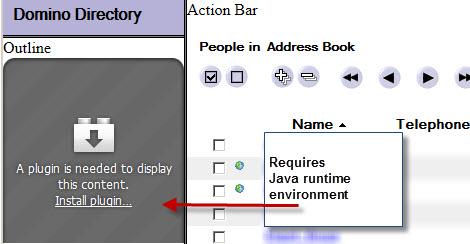Saturday, January 12th, 2013
Disclaimer: In this post, I'm blogging about a subject I do not entirely comprehend. I hope to encourage discussion and learn from the community as I know that there are folks smarter than me who may have already addressed this issue.
I recently read about the
Oracle Java 7 Security Manager Bypass Vulnerability published by the United States Computer Emergency Readiness Team. As I understand it, vulnerabilities have been discovered which could allow a sandboxed application to promote itself in privileges to be able to access files and resources outside of the sandbox - such as accessing your files or internet communication. US-Cert Vulnerability Note
VU#636312 advises disabling or removing completely the Java runtime environment so that web browsers cannot launch Java.
While I understand and am concerned about the security threat, I am also concerned about the impact of disabling or removing the Java runtime environment. In my simple tests I found that web pages and resources ceased to function fully for need of the appropriate Java runtime.

It appears that Oracle can or will release a security update that may address at least part of this threat but questions remain: What would the impact be if Java is uninstalled altogether? How would this likely affect web use? What about the Lotus Notes Components that make use of Java?
I am still trying to wrap my head this and would appreciate any information that you think may help myself or others that may read this post.
Monday, November 26th, 2012
It's hard to fit a long URL into a Tweet or and it can be unsightly to paste it into Facebook. For example this URL would use up 119 characters of a Tweet:
http://www.stdi.com/stdi/home.nsf/e0fdcda544a79270852570d7005e5285/2f89dd64498d734c852577b500033a17!OpenDocument For this reason, many people rely on URL shorteners, such as Bit.ly to provide a simple alias. The resulting URL above comes out as:
http://bit.ly/Thpp2u a total of 20 characters shortened from from 119. Not bad!
The concern I have always had using public link shortening services is what happens when they shut down. Since many of these services are free to the user, they expect to monetize their service with ads, etc. The problem is have no guarantee they will be here in 10 years, or next year, or tomorrow.
I have looked for Open Source URL shorteners and found several that could be implemented by a web savvy programmer. Of course, being partial to the IBM Domino stack, I hoped to find a solution I could run in Domino.
Today, on a quest to find something else, I serendipitously stumbled across
ShortURL for Domino. It's a free download by Dieter Stalder, the founder of STDI Consulting.
Less than 5 Minutes later I had the database on my IBM Domino Server serving up URLS. Since I already have a short domain name (ICA.com) I decided to use that for starters but I plan to add it to all of my domains.
Here is what that 119 character URL at the top of this post looks like when I run it through my URL shortener:
http://ica.com/go/ShortURL The ShortURL app does not generate an unfriendly alias. I can create any unique alias I want.
While this is certainly not a polished app it does the job. It would not take much to enhance this to provide a web interface and to autogenerate and validate links. There may even be an xPages app by now.
In any case, now, I can shorten URLS without concern that the service will go away. And, because it is built on Notes and Domino I can extend the features to suit my needs.
Are you using ShortURL or a similar tool for IBM Domino?
Wednesday, November 21st, 2012
A customer called me with a question I could not immediately answer. After spending a few hours testing various scenarios, I concluded that the Notes for Mac client does not consistently refresh views.
Scenario:
User opens a view and runs an agent or script that will change a field value - let's say the "categories" field.
On the Windows version of Notes, the user can do this and immediately see that the view gets refreshed. The new data is shown in the view.
If user opens the same Notes application on the Mac version of Notes and repeats the process, the view remains static until he either exits the application and reopens the view or he manually selects View\Refresh.
This causes confusion for Mac users of Notes because what they see in the view does not reflect the changes they have just made - at least not until they manually refresh the view.
The desired behavior of course is for the view to be refreshed - just as it is in the Windows version of Notes.
What's strange is that we are using the same code for both clients and the code calls a view refresh.
As far as I can tell, this appears to be specific to Mac version of Notes, but I'm open to other ideas....
Any ideas?
P.S. Using Notes 8.5.3 for Windows and for Mac with all fixpacks.
Thursday, August 30th, 2012
A global enterprise customer with offices in Boston asked me "who else uses Lotus Notes in the Boston area?" I'd like to respond with a list of organizations. I'm not asking for contact names. If you are aware of organizations in the Boston that are presently using Lotus Notes, please post a comment.
Tuesday, August 14th, 2012
I've been following the progress of Julian Buss and his Domino To Go platform for mobile application development and his flagship application,
Notesbook. While I have not yet tried his application personally, it appears to have a the makings of a core information support tool for getting things done with Lotus Notes. I'm particularly pleased to see that there are plans to add support for multiple Notebooks.
We get requests daily looking for mobilization tools to recommend. Soon, I plan to evaluate
Notesbook as a possible companion app to
eProductivity and the free
Reference DB (If you have already done this I'd like to hear from you.)
Meanwhile, Domino To Go, Notesbook and Lotus Domino were recently
featured on Appcelerator Titanium’s Developer Blog.
Congratulations, Julian. Nice to see coverage like this for a productivity tool that works with Domino.








